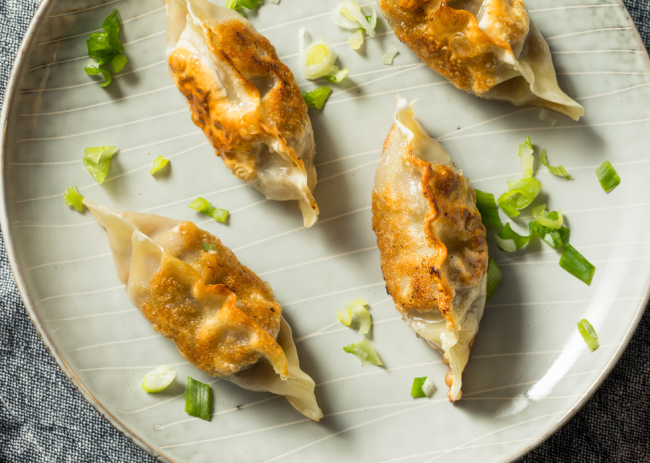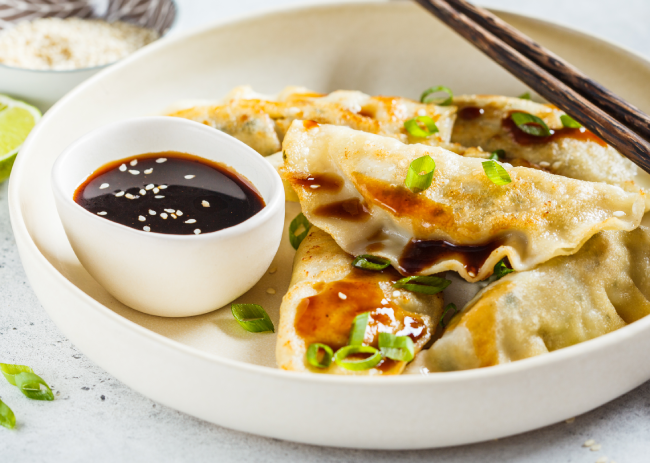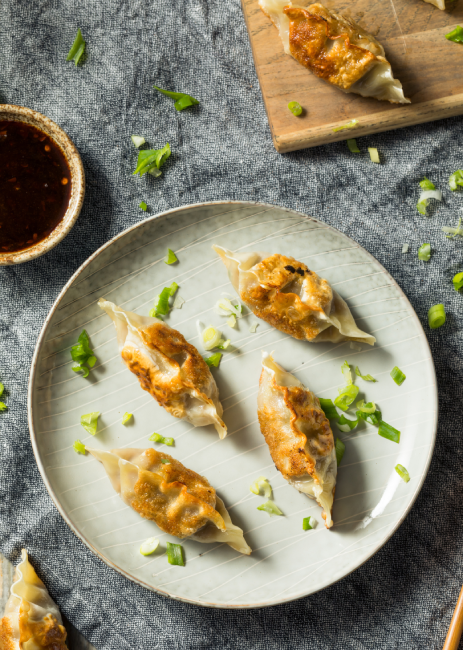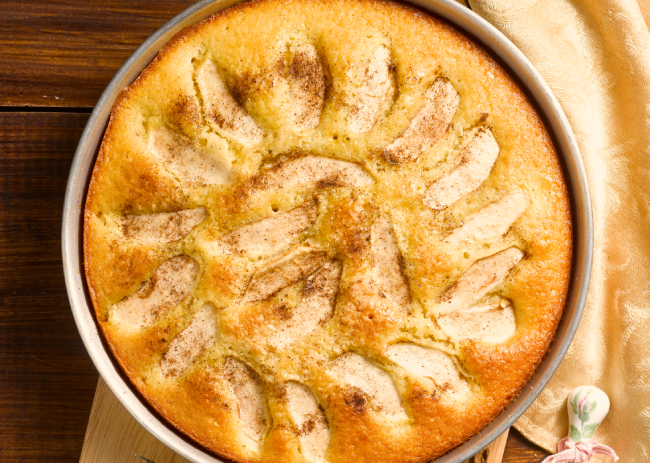Korean Dumplings: Step-By-Step Recipe
Mandu, or Korean dumplings, are a popular type of traditional Korean cuisine. These dumplings are available in a variety of shapes and flavours. And they can be steamed, boiled, pan-fried, or deep-fried. They usually cook with ground meat, veggies, and various seasonings. They then wrap in a thin layer of dough.
The filling of Mandu varies according to the area and the cook’s choice. The most typical fillings are pork, beef, or chicken. They mix with vegetables such as cabbage, carrots, onions, and garlic. Besides, some dishes may incorporate tofu or noodles.
In addition, Mandu dough contains flour, water, and egg, and is rolled out into thin circles. After placing the filling in the centre of the dough circle, the edges are pinched together to seal the dumpling together. Some recipes call for crimped or pleated edges. It gives the dumpling a distinct and ornamental appearance.
Korean dumplings are served as an appetizer but they can also be a main course. You can find it at Korean restaurants, food stalls, and markets, and are a popular street food in Korea. Some of the most popular types of Mandu include:
- Kimchi Mandu: Dumplings filled with kimchi and pork or beef, a spicy and flavorful option.
- Gogi Mandu: Dumplings filled with ground beef and vegetables, a classic and simple option.
- Mandu Guk: A soup made with mandu, broth, and sometimes rice cakes, often served during the Korean Lunar New Year.
- Tteok-mandu-guk: A soup made with mandu and rice cakes. You can serve it on special occasions.
- Gun-mandu: Deep-fried dumplings that have a crispy exterior and juicy filling.
Korean dumplings are a tasty and versatile food. People of all ages and backgrounds enjoy them. They are delicious and filling snacks. You can customize it to suit individual tastes and preferences.
What Are Korean Dumplings?
Korean dumplings have their origin in China. It is even introduced to Korea during the Three Kingdoms period. The recipe evolved over time to combine traditional Korean ingredients and flavours. It culminates in a one-of-a-kind gastronomic experience.
Korean dumplings come in many varieties. Each with its own particular flavour and texture. Mandu with pork and kimchi, and Mandu with beef and tofu. And mandu with shellfish is a popular variety. The dough for the dumplings can also vary. Some recipes use wheat flour and others use rice flour.
In addition, Korean dumplings are a tasty and adaptable dish that can be enjoyed in a variety of ways. They are a staple of Korean cuisine. They received worldwide recognition for their flavour, texture, and cultural significance.
Why This Recipe Works
The Korean dumpling recipe works for several reasons:
- Flavorful filling: The dumpling filling contains ground pork and a variety of seasonings. It adds depth of flavour. You can adjust the individual tastes and preferences by customizing the filling.
- Thin and tender dough: The dumpling dough is of flour, water, and egg, and rolled out into thin circles. The dough is delicate and easy to work with. It allows the dumplings to be wrapped and not fall apart during cooking.
- Versatile cooking methods: Cooking methods for Korean dumplings include steaming, boiling, and deep-frying. This allows for greater cooking versatility. And it helps chefs to generate a variety of textures and flavours.
- Customizable serving options: People in Korea serve the dumplings as a snack or main course. They serve it with a dipping sauce or in a soup. And they top with scallions or other ingredients to add flavour and texture.
In addition, our Korean dumpling recipe is a fantastic option for anyone wishing to prepare a tasty and varied supper or snack. The recipe is adaptable to ingredients and cooking methods. The end result is a wonderful and satisfying dish that everyone will appreciate.
Ingredients Required to Make Korean Dumplings
- 1 medium onion, finely chopped: This recipe needs one medium onion. It should be finely chopped to ensure an even distribution of flavour in the filling.
- 1 pound lean ground pork or beef: This recipe calls for one pound of either lean ground pork or beef. Either meat can be used to make the filling for the dumplings.
- ½ cup chopped tofu (1 small cake): The recipe needs ½ cup of chopped tofu in the filling. It provides a soft texture and a subtle flavour.
- 1 cup finely chopped cabbage: You’ll need one cup of finely chopped cabbage. It is roughly half of a small cabbage head. The cabbage should parboiled beforehand to soften it up for the filling.
- 4 ounces mung bean noodles (they should be soaked in hot water for 15 minutes and then chopped): You’ll need 4 ounces of mung bean noodles. They soaked in hot water for 15 minutes. Or, you can use sweet potato noodles (cooked), which should also be chopped into small pieces.
- 2 tablespoons soy sauce: This recipe calls for two spoons of soy sauce to provide a savoury flavour to the filling.
- 3 cloves garlic, minced: This recipe requires three cloves of garlic. Chop it finely to ensure an even distribution of flavour.
- 1 teaspoon kosher salt: One teaspoon of kosher salt will help to enhance the flavour of the filling.
- 3 teaspoons sesame oil: It adds a nutty flavour and aroma to the filling.
- 1 teaspoon ground black pepper: One teaspoon of ground black pepper helps to add subtle heat to the filling.
- 40 circular Mandu wrappers or 40 Japanese gyoza: They help in wrapping the filling.
- Dumpling dipping sauce, to serve: A dipping sauce usually serves with Korean dumplings. You can make your own or use a store-bought sauce.
Tools Required to Make Korean Dumplings
To make Korean dumplings, also known as mandu, you will need a few essential tools. These include:
- Mixing bowl: A large mixing bowl will need to nix the ingredients for the dumpling filling.
- Rolling pin: You will need a rolling pin to roll out the dumpling wrappers.
- Dumpling wrappers: You can either make your own dumpling wrappers from scratch. Or buy pre-made ones from the store.
- Filling ingredients: The filling ingredients for Korean dumplings can vary. But include ground meat (pork, beef, or chicken), garlic, soy sauce, and sesame oil.
- Chopping board and knife: You will need a chopping board and a sharp knife. It is to chop the vegetables and meat for the filling.
- Spoon: A spoon will help to scoop the filling onto the dumpling wrapper.
- Steamer or frying pan: Once the dumplings assemble, you can steam them. You can also fry them in a pan.
Korean Dumplings Recipe
Make juicy Korean dumplings (Mandu) from scratch with this step-by-step recipe. Take a bite and enjoy this truly satisfying and enjoyable experience!
Servings: 40 dumplings Prep time: 30 minutes Total time: 30 minutes
Firstly, combine the ground pork or ground beef, onion, tofu and noodles in a large mixing bowl.
Secondly, combine the soy sauce, garlic, sesame oil, pepper and salt in a separate small bowl.
Thirdly, mix the seasoning combination into the meat and veggies with your hands.
Next, fill each dumpling wrapper with roughly 1 spoonful of filling.
Then, wet the perimeter of half of the wrapper with your finger.
Next, fold the wrapper in half and press to seal before crimping the edges. Repeat until the filler has been removed.
You can boil, steam, sauté or fry the dumplings as desired.
Boil a large pot half full of water and slide the mandu into the water. When it returns to a boil, reduce to low heat and let it cook for 6-8 minutes.
Place the dumplings in a steamer basket to steam (Jjin Mandu). Steam for 15-20 minutes.
Heat a few inches of canola oil in a fryer to 350°F to deep fry. Fry the dumplings in batches for 2-3 minutes or until golden brown.
Finally, serve with either a simple dipping sauce or a spicy sauce.
Korean Dumplings: Nutritional Information
Total Fat: 9 g
Saturated Fat: 3 g
Cholesterol: 50 mg
Sodium: 432 mg
Total Carbohydrate: 7 g
Dietary Fiber: 1 g
Total Sugars: 1 g
Protein: 19 g
Vitamin C: 8 mg
Calcium: 70 mg
Iron: 2 mg
Potassium: 348 mg
Tips To Make The Best Korean Dumplings
Korean dumplings, or mandu, are a delicious and popular dish in Korean cuisine. Here are some tips to help you make the best Korean dumplings:
- Use the right wrappers: Look for Korean-style dumpling wrappers. Look for those which are thinner and softer than Chinese-style dumpling wrappers. You can usually find them at Korean grocery stores or online.
- Mix the filling well: The filling should be well-mixed and distributed. So that each dumpling has a consistent taste and texture. Use your hands to mix the filling.
- Don’t overfill the wrappers: Be sure to leave a little space at the top of the wrapper, so that you can seal it. If you overfill the wrapper, the dumpling may burst during cooking.
- Seal the dumplings well: Use a little water or egg wash to moisten the edge of the wrapper. Do it before folding it over the filling. Press the edges together to seal the dumpling.
- Cook the dumplings right: You can boil, steam, or fry the dumplings. Boiling is the most traditional method for Korean mandu. Bring a large pot of water to a boil, and then add the dumplings. Cook for about 5-7 minutes, or until the dumplings float to the surface and the filling is cooked through.
- Serve with dipping sauce: And then You can serve Korean dumplings with a dipping sauce. This dip contains soy sauce, rice vinegar, sesame oil, and chopped green onions. Mix the ingredients together and adjust the seasoning to taste.
With these tips, you can make delicious and authentic Korean dumplings at home. Enjoy!
Storing & Freezing
If you have leftover Korean dumplings, here are some tips for storing and freezing them:
- Refrigerating: You can store cooked dumplings. Store it in an airtight container in the refrigerator for up to 3-4 days. Make sure to let them cool down completely before storing them.
- Freezing: You can freeze the uncooked dumplings for later use. Place the dumplings on a baking sheet lined with parchment paper, making sure they don’t touch. Freeze them for 1-2 hours, or until hard, before transferring them to a freezer-safe bag or container. You can freeze the dumplings for up to 3 months.
- Thawing: To cook frozen dumplings, thaw them in the refrigerator overnight. Or at room temperature for 30 minutes to 1 hour. Do not thaw them in the microwave or under running water, as this may cause the dumplings to become mushy.
- Cooking: Once the dumplings have been thawed, cook them according to your preference. Like boiling, steaming, or frying. The most frequent method for making Korean mandu is to boil it. Bring a pot of water to a boil. Then add the dumplings and cook for 5-7 minutes, or until they float to the surface and cooked through.
Finally, You may eat delicious Korean dumplings whenever you want with these techniques. Even if you have leftovers or wish to make them ahead of time.
FAQs
What Are Korean Dumplings Called?
Korean dumplings are “mandu” in Korean. Mandu fills with various ingredients, for example, ground pork, beef, vegetables, tofu, or kimchi. They are a popular dish in Korean cuisine and people serve it as an appetizer, side dish, or main dish.
What Is The Difference Between Korean Dumplings And Chinese Dumplings?
Korean dumplings, or mandu, and Chinese dumplings, or jiaozi, have some similarities. But also some key differences. Here are some of the main differences:
- Wrappers: Korean dumpling wrappers are thinner and softer than Chinese dumpling wrappers. They are often thicker and chewier.
- Filling: Korean dumplings tend to have a more chopped filling. Often including tofu, glass noodles, and vegetables. Chinese dumplings, so, can have a variety of fillings. Including meat, seafood, and vegetables, and the filling is often more chopped.
- Shape: Korean dumplings usually has round or crescent-shaped. While Chinese dumplings are crescent-shaped with a flatter bottom and pleated edges.
- Cooking method: You can boil, steam, or fry both Korean and Chinese dumplings. Korean dumplings are mostly boiled, while Chinese dumplings are often steamed or pan-fried.
- Dipping sauce: The dipping sauces for Korean and Chinese dumplings also differ. People serve the Korean dumplings with a dipping sauce made from soy sauce, and sesame oil. While They serve Chinese dumplings with a mixture of soy sauce, vinegar, and chilli oil.
Are Mandu And Gyoza The Same Thing?
Mandu and gyoza are both popular types of dumplings, but they are not exactly the same thing. Mandu is the Korean word for dumplings, while gyoza is the Japanese word for dumplings. However, One of the main differences between the two is the filling. Mandu often contains finely chopped vegetables, glass noodles, and tofu.
While gyoza usually contains a mixture of meat and vegetables. They are more coarsely chopped. The shapes are also slightly different, with mandu often being round or crescent-shaped. While gyoza is usually crescent-shaped or shaped like a purse with pleated edges. While both mandu and gyoza can boiled, steamed, or fried. Mandu is boiled, while gyoza is often pan-fried or deep-fried.
Are Korean Dumplings Healthy?
Korean dumplings, also known as mandu, can be a healthy and nutritious meal option. Only if made with the right ingredients and cooked in a healthy manner. Dumplings filled with vegetables, tofu, and lean protein sources can provide a nutritious meal. Vegetables such as cabbage, and carrots can add fibre, and minerals to the filling.
While lean proteins can provide amino acids needed for muscle growth and repair. Yet, it is important to keep in mind that the dumpling wrappers are made with wheat flour. And thus can be high in carbohydrates.
Additionally, the sodium content of dumplings can be high. Especially if they are served with a salty dipping sauce or if MSG is used in the filling. To make Korean dumplings healthier, consider using whole wheat or rice flour wrappers. And fillings that are lower in fat and sodium.
What Are Indian Dumplings Called?
In India, People call dumplings by different names depending on the region and language. For example, in the northern part of India, called “Momo” or “Momozi”. While in the eastern state of West Bengal, called “Macher Muro,” which means fish head. In the southern states of India, called “Kuzhi Paniyaram” or “Appam”. And in the western state of Maharashtra, people call it “Modak.”
Is Dumpling Same As Momos?
Dumplings and momos share some similarities but they are not exactly the same thing. Momos are a type of dumpling that originated in Tibet. And are now popular in many parts of South Asia, especially in Nepal, Bhutan, and Northern India. The main difference between momos & dumplings is the filling and the seasoning.
Momos contain spiced meat, such as ground chicken or lamb, or vegetables. They season with a blend of herbs and spices, including garlic, ginger, and turmeric. The dough for momos is also thinner than that used for other types of dumplings. And the shape is usually crescent or half-moon shaped.
While dumplings can have a variety of fillings. Including vegetables and meat. They relate to Chinese cuisine and seasons with soy sauce and spices. The shape of dumplings can also vary, but they are often round or crescent-shaped. In summary, momos are a type of dumpling. They are distinct from other types of dumplings due to their filling, seasoning, and shape.
In Conclusion
Lastly, Korean dumplings, also known as “Mandu,” are a delicious and versatile dish. You can enjoy it in a variety of ways. Making Korean dumplings at home is a fun and rewarding experience. It allows you to customize the filling and seasoning to your taste.
Follow a few simple steps, such as filling, shaping, and cooking them in boiling water. You can create a batch of tasty and healthy Korean dumplings and serve them as an appetizer or a main dish. Whether filled with vegetables, Korean dumplings are a nutritious meal option. Everyone can enjoy this.
With a little practice, you can master the art of making Korean dumplings. You can also impress your family and friends with your culinary skills.

Korean Dumplings: Step-By-Step Recipe
Ingredients
- 1 medium onion finely chopped
- 1 lb lean ground pork or beef
- ½ cup chopped tofu (1 small cake)
- 1 cabbage finely chopped
- 4 ounces mung bean noodles (they should be soaked in hot water for 15 minutes and then chopped)
- 2 tbsp soy sauce
- 3 cloves garlic minced
- 1 tsp kosher salt
- 3 tsp sesame oil
- 1 tsp ground black pepper
- 40 circular Mandu wrappers or 40 Japanese gyoza
- Dumpling dipping sauce to serve
Instructions
- Firstly, combine the ground pork or ground beef, onion, tofu and noodles in a large mixing bowl.
- Secondly, combine the soy sauce, garlic, sesame oil, pepper and salt in a separate small bowl.
- Thirdly, mix the seasoning combination into the meat and veggies with your hands.
- Next, fill each dumpling wrapper with roughly 1 spoonful of filling.
- Then, wet the perimeter of half of the wrapper with your finger.
- Next, fold the wrapper in half and press to seal before crimping the edges. Repeat until the filler has been removed.
- You can boil, steam, sauté or fry the dumplings as desired.
- Boil a large pot half full of water and slide the mandu into the water. When it returns to a boil, reduce to low heat and let it cook for 6-8 minutes.
- Place the dumplings in a steamer basket to steam (Jjin Mandu). Steam for 15-20 minutes.
- Heat a few inches of canola oil in a fryer to 350°F to deep fry. Fry the dumplings in batches for 2-3 minutes or until golden brown.
- Finally, serve with either a simple dipping sauce or a spicy sauce.
Notes
- Use the right wrappers: Look for Korean-style dumpling wrappers. Look for those which are thinner and softer than Chinese-style dumpling wrappers. You can usually find them at Korean grocery stores or online.
- Mix the filling well: The filling should be well-mixed and distributed. So that each dumpling has a consistent taste and texture. Use your hands to mix the filling.
- Don't overfill the wrappers: Be sure to leave a little space at the top of the wrapper, so that you can seal it. If you overfill the wrapper, the dumpling may burst during cooking.
- Seal the dumplings well: Use a little water or egg wash to moisten the edge of the wrapper. Do it before folding it over the filling. Press the edges together to seal the dumpling.
- Cook the dumplings right: You can boil, steam, or fry the dumplings. Boiling is the most traditional method for Korean mandu. Bring a large pot of water to a boil, and then add the dumplings. Cook for about 5-7 minutes, or until the dumplings float to the surface and the filling is cooked through.
- Serve with dipping sauce: And then You can serve Korean dumplings with a dipping sauce. This dip contains soy sauce, rice vinegar, sesame oil, and chopped green onions. Mix the ingredients together and adjust the seasoning to taste.






Amazing
Korean Dumplings is made my day wow!!
1st try & turned delicious.
my favorite dumplings,delicious and yummy thanks for sharing!
Wow..its delicious.Thankyou for this valuable recipe. Texture, color , taste all are amazing!
Amazing
Korean Dumplings!found a perfect article for this dish.
Wow ! Such a nice dish and recipe.
Keep posting
Appetizing….
Perfectly delicious
Another Korean recipe? Wow, can’t wait to dig into it!
yummy and delicous ..
I love these dumplings and try and make them at least once a month!
Great recipe!
After trying this recipe, I can’t wait to make it again and share it with friends and family.
dumplings are ones which i saw in kdrama and im gonna try it now